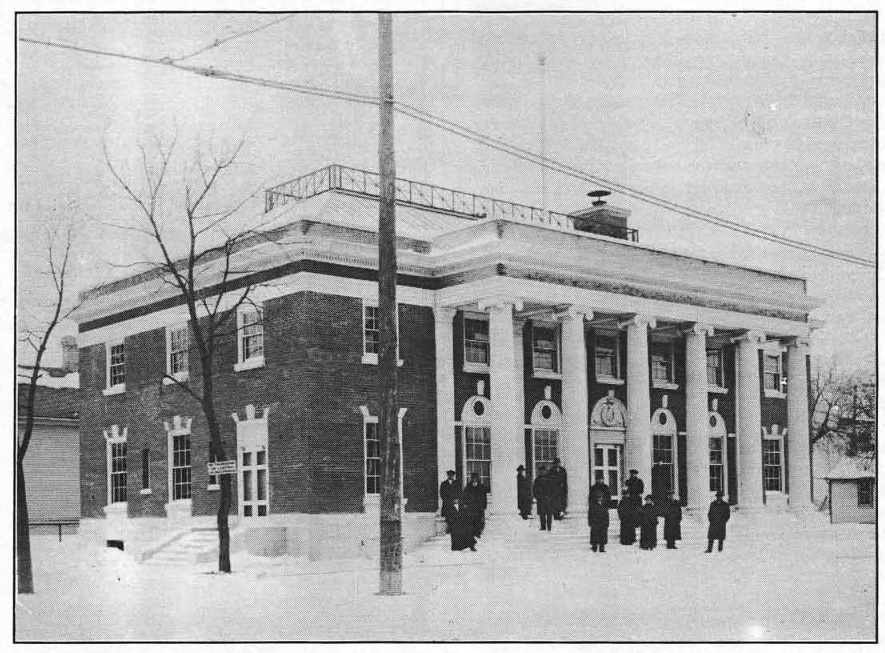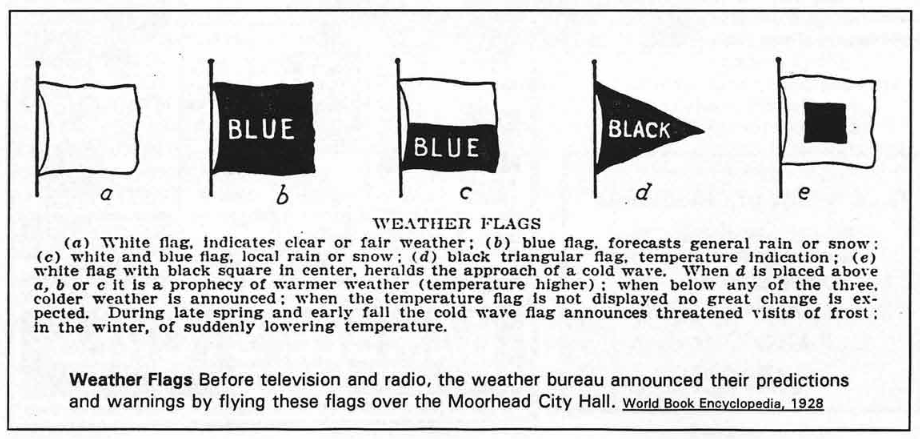|
38 Days of Sub-Zero Temps: Clay County's 1936 Winter Still Coldest on Record Mark Peihl February 16, 2021 (adapted from CCHS Newsletter, January/February 1993) * * * * * * * * * * On Tuesday morning, January 14, 1936, local U.S. Weather Bureau observer Roy J. McClure received a telegraphic message from Washington at his office in the Moorhead Post Office (today The Rourke Art Gallery + Museum). A severe cold wave was approaching Clay County from the northwest. McClure quickly phoned the local radio stations and newspapers with the warning and made his way to City Hall on 5th Street and Center Avenue. McClure ran a square white flag with a black square in the middle of it up the flag pole — the weather bureau's official signal to warn citizens of a cold wave. It had already been a cold winter. November was the fourth coldest on record and the temperature had not been above freezing since December 15. Just the previous week the county had been stung with twenty-below weather. It must have been cold raising that flag. The temperature was 1°F with a 12 mile per hour wind. But little did McClure know that it would be six long weeks before Clay County would enjoy such balmy weather again. For 38 days between January 15 and February 20 the temperature at Moorhead never reached above zero, the longest such streak in the county's history. Eight times morning lows reached -30°F, twice it hit -37°F, and three blizzards added to the fiasco. It all helped to make the winter of 1936 the coldest on record. The first week of the cold snap was not that bad. Lows were around -15°F and highs about -5°F, and winds were light. Newspapers hardly mentioned the cold. But Tuesday afternoon, January 21, the bottom dropped out. By midnight the temperature was -37°F with a 15 mile per hour wind. That's a wind chill of -85 degrees. The high that day was -29°F. Few folks in Moorhead bothered to try starting their cars and fewer succeeded. Packed city buses managed to stay on schedule, but the Fargo-Moorhead Electric Street Railway routes were completely disorganized. The intense cold created a frosty film on the street car tracks. Without adequate traction it took the cars an hour to complete a 45-minute loop. Taxi cabs raced the deserted streets getting people to work and stores. Many folks waited an hour for a ride. The Fargo companies raised their fares from 15 cents to 25 cents and still did a booming business. Moorhead Judge N.I. Johnson bought a thermometer at a local hardware store, stepped outside and watched astonished as its mercury plummeted 102 degrees in moments. Most people just stayed home and talked on the phone. Northwestern Bell put on all the operators they had and could not handle the estimated 12,000 calls placed between 7:30 and 9 a.m., four times the normal load. Most of the calls were to cab companies or about school. Classes were held but attendance was off by a third. Conditions in the country were worse. Thermometers near Ulen hit -42°F and Downer residents reported -38°F for a high on Wednesday. J.B. Olsen from Hawley had to melt snow for his 16 head of stock when his well froze. Most rural schools closed for the week. Drifts blocked many township roads. A lot of snow had already fallen that winter. It was light and dry and blew like crazy with even a moderate wind. North of Georgetown WPA workers added blocks of snow to increase the height of a snow fence, but 10 foot drifts piled up anyway. On Saturday, after three days of minus thirty, the temperature "moderated" for 10 days. It even reached zero a couple of times. But on Tuesday, February 4, a strong north wind brought back frigid air. On Friday, highs edged up to -12°F and snow started to fall. By Sunday an additional 4.5 inches had fallen and blown sideways. City, state, and county road crews worked round the clock to keep main routes open, but most rural roads were clocked. The Hitterdal and Felton areas were particularly hard hit with 12 to 14 foot drifts. The Fargo Forum reported drifts "packed hard as concrete" by the wind. Crews used dynamite to clear some North Dakota roads. By Wednesday things were more under control. Then it started snowing again. Frustrated road crewmen sat as "canyons" they had spent half a day digging out fIlled in an hour with new white stuff. On Friday the weather cleared and the temp plummeted to -37°F again. The Moorhead Daily News joked that the only break Moorheadites got from shoveling coal into their furnaces was to run upstairs and phone for more coal. In Iowa, fuel became so short that armed guards were posted on coal trains. There was no such problem here. Most Clay County coal came from dock storage facilities at Duluth or open pit mines in North Dakota and Montana. Local coal dealers reported their business up by 25 to 75% over normal, but except for a couple of popular grades there was plenty to go around. However, at Hitterdal and Ulen, where snow blockedrail deliveries for a time, dealers limited what they would sell. As furnaces stoked up, chimney fires became common. Moorhead fire fighters fought three fires on one -37°F night. On Sunday, the third blizzard in less than 10 days struckand Clay County residents had had enough. The Moorhead Country Press said that old timers' stories of how cold it was in the old days were getting a lot less interesting. A Spring Prairie resident complained that his neighbors talked of nothing except coal, cold weather and firewood. With their customers marooned at home by snow and cold, merchants reported business was terrible. The previous fall male students at Moorhead State Teachers College had started a fad of going about hatless. The -30°F weather stopped that fast. Half the residents of Ulen had to haul water when their pipes froze. Although hundreds died around the country from the cold, Clay County recorded only one death. On January 22, WPA worker Gerald Payseno tried fixing a tire in a closed garage with his truck's motor running. He was overcome by exhaust fumes. Wildlife suffered terribly. Newspapers carried stories about woodpeckers frozen to trees, chickadees stuck to iron pipes, and even a rabbit found with his tongue on an ax head. Residents reported pheasants flocking in farmyards. Local game warden Robert Streich said 1936 was the worst year for wildlife he had ever seen and predicted the weather would set back pheasant production by five years. Streich pleaded with farmers to set out feed for game birds. Local Rod and Gun Clubs raised funds for bird feed. Streich himself speared 1000 pounds of rough fish at the north Red River Dam to feed pheasants. The ice on the river froze 36 inches deep and several small lakes winter-killed completely. County residents grimly dug out again and hung on. Finally, on Friday, February 21, thermometers registered at a sizzling 8°F. Soon after, 32°F weather brought a sleet storm that turned roads to ice and yet another blizzard followed, but the back was finally broken on the grand daddy of all Clay County cold waves. When the previous record for extended sub-zero weather was broken (a wimpy 11 days in 1889) the Moorhead Daily News editorialized "already youngsters of 1936 are being taught the momentous news, so that in the dimfuture when they achieve the status of grandfathers they can chuckle over a younger generation complaining about cold weather, saying: 'Now when I was a lad .... '"
3 Comments
|
Visit Us
|
Resources
|
|



 RSS Feed
RSS Feed